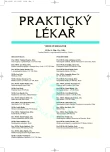Chronic renal failure in primary care
Chronická renální insuficience v primární péči
Prevalence nemocných s chronickým selháním ledvin léčených jednou z metod náhrady funkce ledvin stále roste. Nejčastější příčinou selhání ledvin je nyní diabetická nefropatie a nefroskleróza. Dialyzační léčba je velmi nákladná, obvykle je na léčbu 0,1–0,2 % populace vynakládáno 4–7 % celkových nákladů na zdravotní péči. Kvalita života dialyzovaných pacientů je ve srovnání s nedialyzovanými pacienty v chronické renální insuficienci výrazně snížena. Mortalita pacientů s terminálním selháním ledvin léčených dialýzou zůstává velmi vysoká a činí 20–25 % ročně. Pacienti po úspěšné transplantaci ledviny mají sice výrazně nižší roční mortalitu než dialyzovaní pacienti (cca 10krát), ale i jejich mortalita je stále významně vyšší než u věkově srovnatelné běžné populace.
V současné době máme omezené informace o mortalitě a riziku vývoje terminálního selhání ledvin vyžadujícího náhradu funkce ledvin u homogenní neselektované populace pacientů s pokročilou chronickou renální insuficiencí. Dostupné informace se týkají pacientů z randomizovaných klinických studií, kteří představují selektovanou populaci nemocných s pravděpodobně menším zastoupením komorbidit než obvykle, a tedy i lepší prognózou. Cílem konzervativního léčení je především úprava metabolických poruch nemocných spojených se sníženou renální funkcí a kromě toho v řadě případů oddálení zahájení dialyzačního léčení.
Klíčová slova:
renální insuficience a selhání, léčebné možnosti
Authors:
V. Teplan
Authors‘ workplace:
Subkatedra nefrologie IPVZ, Praha
; Přednosta: prof. MUDr. Vladimír Teplan, DrSc.
; Klinika nefrologie, Transplantcentrum IKEM, Praha
Published in:
Prakt. Lék. 2007; 87(1): 4-10
Category:
Reviews
Overview
The prevalence of patients with chronic renal failure treated by one method of renal function replacement is steadily rising. Nowadays, the most frequent cause of renal failure is diabetic nephropathy and nephrosclerosis. Haemodialysis treatment is very expensive, in general the treatment of 0.1–0.2% of the population consumes 4–7% of the total health care expenditure. In comparison with non-dialyzed renal failure patients, the quality of life of dialyzed patients is substantially lower. Mortality of patients with end-stage renal disease treated by haemodialysis remains very high: 20–25% per year. The yearly mortality of patients after successful kidney transplantation is markedly lower than in haemodialyzed patients (cca 10 times), however their mortality remains significantly higher than in the age-matched population.
At present we have scarce information about mortality and risk of development of a haemodialysis requiring end-stage renal disease in a homogenous unselected population of patients with advanced renal failure. Data available refer to patients from randomized clinical trials which represent a selected population with a probably lower incidence of co-morbidities than usual, and thus with a better prognosis. A conservative treatment aims to control metabolic disturbances associated with an impaired renal function, and to postpone commencement of haemodialysis treatment in certain cases.
Key words:
renal failure, end-stage renal disease, therapeutic modalities
Labels
General practitioner for children and adolescents General practitioner for adultsArticle was published in
General Practitioner

2007 Issue 1
- Memantine Eases Daily Life for Patients and Caregivers
- Metamizole at a Glance and in Practice – Effective Non-Opioid Analgesic for All Ages
- Metamizole vs. Tramadol in Postoperative Analgesia
- Memantine in Dementia Therapy – Current Findings and Possible Future Applications
- What Effect Can Be Expected from Limosilactobacillus reuteri in Mucositis and Peri-Implantitis?
Most read in this issue
- Chronic renal failure in primary care
- Craniopharyngioma in 79 years old man – a case study
- Wilson’s disease
- Hypoglycaemia-associated autonomic failure, its clinical assessment and treatment.
